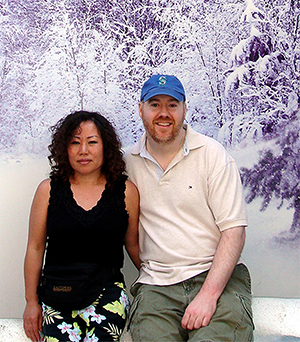

Mindful Living
Discover how mindfulness can enrich your daily life. Whether you're new to the practice or deepening your journey, these insights from William and Hui Cha Stanek provide guidance on living with awareness, purpose, and connection.

Transform your life with practical wisdom. Discover William Stanek's 'Living Well' series—your guide to a balanced and fulfilling life.
Discover William Stanek's Exclusive Art Collection
Explore and purchase the stunning art featured on this site. Own a piece of William Stanek's unique and captivating artwork today!
(May 9, 2025) Mindful Resilience: Bouncing Back from Burnout with the Stanek Spirit
Burnout is a modern-day epidemic, a state of physical, emotional, and mental exhaustion that leaves you feeling drained and detached from the things that once brought you joy and purpose. It’s a challenge that many of us face at some point in our lives, and for Hui Cha and me, it was no different. We’ve both experienced burnout firsthand, feeling the weight of overwhelming responsibilities, relentless demands, and the exhaustion that comes from pushing ourselves too hard for too long.
But burnout doesn’t have to be the end of the story. With the right tools and mindset, it’s possible to bounce back, recover your energy, and rediscover your purpose. For us, mindfulness was the key to this recovery. By being present, recognizing the signs of burnout early, and using mindfulness practices to restore balance and focus, we were able to regain our resilience and move forward with renewed strength.
In this article, we’ll explore the nature of burnout, discuss how mindfulness can aid in recovery, and share techniques for recognizing and addressing burnout before it takes hold. We’ll also share a personal story of how mindfulness helped us overcome burnout and offer practical tips for creating a sustainable, mindful approach to work and life balance. Through our experiences, we hope to inspire you to use mindfulness as a tool for resilience, recovery, and growth.
Understanding Burnout: A Crisis of Exhaustion
Burnout is more than just feeling tired; it’s a state of chronic stress that leads to physical and emotional exhaustion, cynicism, and a sense of ineffectiveness. It often occurs when we’ve been pushing ourselves too hard for too long, neglecting our own needs in the process. Burnout can affect anyone—whether you’re a professional, a parent, a caregiver, or someone juggling multiple roles.
The Signs of Burnout
Burnout doesn’t happen overnight; it’s a gradual process that can sneak up on you if you’re not paying attention. Some common signs of burnout include:
- Physical exhaustion: Persistent fatigue, even after a good night’s sleep, or feeling physically drained without any apparent reason.
- Emotional detachment: Feeling distant or disconnected from your work, relationships, or activities that once brought you joy.
- Cynicism or negativity: Developing a more negative outlook on life, feeling hopeless or trapped, or becoming increasingly critical or irritable.
- Decreased performance: Struggling to concentrate, feeling less productive, or experiencing a decline in the quality of your work.
- Loss of motivation: Feeling a lack of purpose or enthusiasm for your work or other responsibilities, and struggling to find the energy to keep going.
For us, recognizing these signs early was crucial in addressing burnout before it became overwhelming. Mindfulness played a key role in this recognition, helping us stay attuned to our physical and emotional states and take action when we noticed the warning signs.
Using Mindfulness to Recover from Burnout
Mindfulness is a powerful tool for recovery from burnout, as it helps you reconnect with yourself, recognize your limits, and restore your energy and focus. Here’s how mindfulness can aid in recovering from burnout:
-
Mindful Awareness: Recognizing the Signs Early
- One of the first steps in recovering from burnout is recognizing it early, before it becomes debilitating. Mindfulness helps you tune into your body and mind, allowing you to notice the early signs of burnout—such as fatigue, irritability, or loss of motivation.
- How to Practice Mindful Awareness:
- Set aside time each day for a mindfulness check-in, where you take a few minutes to observe your physical and emotional state. Pay attention to any signs of stress or exhaustion.
- Notice how you’re feeling throughout the day—whether you’re energized or drained, motivated or disconnected. Be honest with yourself about how you’re doing.
- If you notice signs of burnout, take action early by adjusting your workload, seeking support, or incorporating more self-care into your routine.
-
Mindful Rest: Recharging Your Energy
- Rest is essential for recovering from burnout, but it’s not just about getting more sleep. Mindful rest involves engaging in activities that truly relax and rejuvenate you, allowing your mind and body to recover from stress.
- How to Practice Mindful Rest:
- Identify activities that help you relax and recharge—whether it’s taking a walk in nature, practicing yoga, meditating, or simply spending quiet time alone.
- Make rest a priority in your daily routine, setting aside time for these activities without feeling guilty or pressured to be productive.
- Practice mindful breathing or meditation to help calm your mind and release tension. Focus on the present moment, letting go of any worries or stress.
-
Mindful Boundaries: Protecting Your Energy and Well-being
- Burnout often occurs when we take on too much, neglecting our own needs in the process. Mindful boundaries involve setting clear limits on your time and energy, ensuring that you’re not overextending yourself.
- How to Practice Mindful Boundaries:
- Reflect on your current commitments and responsibilities. Are there areas where you’re taking on too much? Are there activities that drain your energy without bringing you joy or fulfillment?
- Set boundaries around these areas, whether it’s saying no to additional tasks, delegating responsibilities, or carving out time for self-care.
- Communicate your boundaries clearly and assertively, without feeling guilty or obligated to explain yourself. Remember that protecting your well-being is essential for long-term resilience.
-
Mindful Purpose: Reconnecting with What Matters
- Burnout often leaves you feeling disconnected from your sense of purpose or motivation. Mindful purpose involves reconnecting with what truly matters to you—your values, passions, and goals—and aligning your actions with these priorities.
- How to Practice Mindful Purpose:
- Take time to reflect on what gives your life meaning and purpose. What activities or goals make you feel fulfilled? What values guide your decisions and actions?
- Focus on these priorities in your daily life, making choices that align with your purpose and values. Let go of activities or commitments that don’t support your sense of purpose.
- Use mindfulness practices like journaling, meditation, or visualization to stay connected to your purpose and to remind yourself of what truly matters.
Personal Story: Overcoming Burnout with Mindfulness
There was a time when I hit a wall—a point where the demands of work, family, and life had pushed me to the brink of burnout. I was exhausted, both physically and mentally, and I felt like I was running on empty. My motivation was gone, and I was simply going through the motions, trying to keep up with everything while feeling increasingly disconnected from my own life.
It was Hui Cha who first noticed the signs. She saw that I was withdrawing, that my energy was low, and that I was losing my sense of purpose. She encouraged me to take a step back and to use mindfulness to reconnect with myself and address the burnout before it got worse.
I started with small steps—taking a few minutes each morning to check in with myself, practicing mindful breathing to calm my mind, and setting boundaries around my time and energy. I also made a conscious effort to reconnect with what mattered to me—spending time with my family, focusing on my passions, and letting go of the tasks that were draining my energy.
Slowly but surely, I began to recover. I found that by being mindful of my needs and limits, I could regain my energy and motivation. Mindfulness helped me not only to recover from burnout but also to build a more sustainable approach to work and life—one that allowed me to stay resilient, focused, and connected to my purpose.
Practical Tips for Creating a Sustainable, Mindful Approach to Work and Life Balance
Recovering from burnout requires more than just short-term fixes; it involves creating a sustainable approach to work and life that prioritizes your well-being. Here are some practical tips for integrating mindfulness into your daily routine to maintain balance and resilience:
-
Prioritize Self-Care:
- Make self-care a non-negotiable part of your daily routine. This includes getting enough sleep, eating well, exercising, and taking time for relaxation and hobbies.
- Practice mindfulness during self-care activities, such as mindful eating, walking, or meditation, to enhance their restorative effects.
-
Schedule Mindful Breaks:
- Incorporate regular breaks into your workday, where you step away from your tasks and engage in a mindful activity. This could be a few minutes of deep breathing, a short walk, or simply sitting quietly.
- These breaks help you recharge and prevent burnout by giving your mind and body time to rest and recover.
-
Set Clear Priorities:
- Reflect on your values and goals, and set clear priorities that align with them. Focus on the activities and commitments that are most important to you, and let go of those that don’t serve your purpose.
- Use mindfulness to stay connected to these priorities, making intentional choices that support your well-being and long-term goals.
-
Practice Mindful Delegation:
- Recognize that you don’t have to do everything yourself. Delegate tasks that can be handled by others, and trust them to do the job well.
- Mindful delegation helps you manage your workload more effectively, freeing up time and energy for the activities that matter most to you.
-
Reflect and Adjust:
- Regularly reflect on your work-life balance and make adjustments as needed. Use mindfulness practices like journaling or meditation to assess how you’re feeling and to identify areas where you may need to make changes.
- Remember that maintaining balance is an ongoing process, and it’s okay to adjust your approach as your needs and circumstances change.
Conclusion: Mindfulness as a Path to Resilience and Recovery
For Hui Cha and me, mindfulness was the key to overcoming burnout and regaining our resilience. By staying present, recognizing the signs of burnout early, and using mindfulness practices to restore balance and focus, we were able to bounce back from exhaustion and reconnect with our purpose. We learned that mindfulness isn’t just a tool for recovery—it’s a way of life that helps you maintain long-term resilience, energy, and fulfillment.
We believe that mindfulness is essential for anyone looking to recover from burnout or prevent it from happening in the first place. By integrating mindfulness into your daily routine, you can create a more sustainable approach to work and life—one that prioritizes your well-being, supports your goals, and allows you to thrive.
We encourage you to explore the mindfulness techniques and tips we’ve shared and to apply them in your own life. Whether you’re currently facing burnout or looking to prevent it, mindfulness can help you build the resilience and strength needed to navigate life’s challenges with clarity, purpose, and grace.

Join William at the crossroads of technology, business, and leadership, where true influence isn't about titles - it's about inspiring action, driving change, and guiding others with integrity. Discover how authentic leadership can transform not just careers, but entire industries.
Bring Inspiration Home
Enhance your space with William Stanek's evocative art. Each piece is crafted to inspire and uplift your everyday life.

Support The Lights of Paris by Robert Stanek, William Stanek's pen name! Through vivid historical detail and deeply moving character stories, Robert takes readers on an unforgettable journey through one of history’s most transformative times.
















